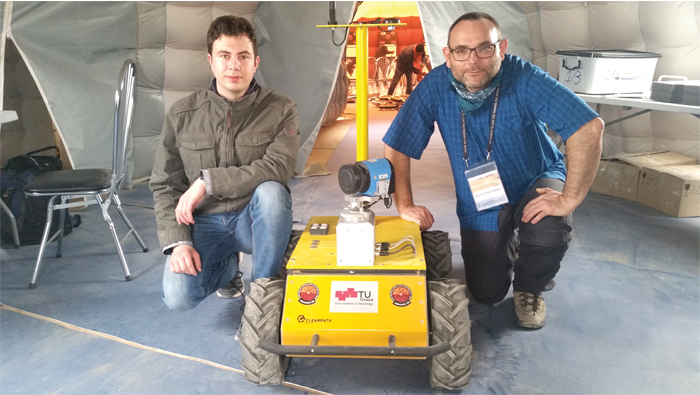
Marmul: Having put in hundreds of thousands of dollars into the development of a new Mars rover last year, scientists are now putting it through its final field test on Martian terrain, right here in Oman.
Husky rover is one of the many experimental prototypes that are being tested in the Dhofari desert in the town of Marmul, some 250km from the city of Salalah, as part of AMADEE 18, a Mars simulation mission run by the Austrian Space Forum (OeWF or Oestereichiches Weltraum Forum) in the Sultanate.
Husky was developed by professor Gerald Steinbauer, an astrophysicist and robotics specialist, in collaboration with his student Michael Stradner. The team received the robotic body from a Canadian firm and began working on the software and computer that would help pilot the new rover. Its finest feature is a 360-degree laser turret that helps map the surface around it, along with a GPS antenna, which allows for remote location sensing and piloting.
New experiments
“We had heard about the Austrian Space Forum’s ideas to develop new experiments and prototypes to discover Mars. Because we were in the process of creating a robot that was capable of mapping out certain areas using laser scanning, we decided to pitch this idea to them, and they really liked it and decided to take us on board,” Steinbauer, who is also a professor of applied robotics at the Institute of Software Technology at Graz University of Technology (TU Graz) in Austria, said.
**media[822009]**
Steinbauer and Stradner will now spend 10 days at the AMADEE 18 base camp in Marmul to ensure that their Husky is able to traverse the terrain, geographically similar to that of Mars, and will check the software for any glitches.
Husky’s development began a year ago, with the duo adding to the already existing robotic body a computer, a laser scanning turret, and a GPS tracker to allow for detection in case it gets lost, once a protective cover has been put in place for the rover.
“Initially, we began testing the Husky in Austria, where we took it to places such as public parks and apartment blocks so that we could scan and map the area around us. The laser on the top of the Husky maps the area in a 360-degree arc around it once, and then continues to map it until it has a clear image of what is around it. Once it was able to completely map the area we could move onto another one,” Steinbauer said.
“We had to constantly work on developing the Husky because there were periodical field trials scheduled for it in Innsbruck at the OeWF headquarters. We had to show them the progress we had made on a regular basis.
“One of our final tests was actually mapping the OeWF headquarters itself. We then added colours to show the height of different buildings and surroundings, so that it would be easy for people to understand the gradient of places,” he added.
Developing the software for the rover, though, posed even more challenges.
“Initially, Husky was only able to go in a straight line and we were unable to make it climb. This was something we had to look at over and over again.
“It took some time to make it work properly because this made it difficult to get it out of pits and craters.
“The software had to be perfect, because after 10 days the astronauts would be controlling the Husky on their own, or we would be doing it remotely and we could only give them technical advice in case something went wrong. We would not be able to physically fix it for them,” Stradner said.
“It is an honour to be a part of this mission because the Austrian Space Forum is really passionate about what they do, and it is great to know that this Husky will one day be with them when man first sets foot on Mars,” he added.